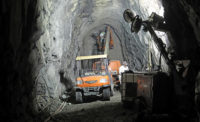...projects in the FRA competition, says MDOT spokeswoman Erin Henson. The biggest item in the state’s pre-application is $6 billion for a Baltimore-to-Washington magnetic-levitation line segment. Henson says current law prohibits the state from spending funds on maglev, but she says the project “was important to [Baltimore] and we agreed to submit it.”
Midwest states’ applications “appear to be very well coordinated,” says Harnish. The region’s plan includes 110-mph service from Chicago to St. Louis, Chicago to Milwaukee to Madison, Wis., and Chicago to Detroit.
Jeff Levy, president and CEO of RailWorks Corp., New York City, says, “The most excitement is among those who will do the studies, the engineering, the permitting [and] design.” But Levy fears DOT will spread the $8 billion too thinly and would prefer to see funds focused on “the project that appears to be a combination of ‘most doable, most benefit, least impact.’ It could be one state-of-the-art system, one commuter-speed system at 125 mph, one start-up system.”
LaHood acknowledges limits. “We know we’re not going to fund all the high-speed rail with tax dollars,” he says. “Some of it’s going to have to be private investment. And we know there are private investors out there that are ready to do that.” FRA says pre-applications from California, Nevada and New York include funding from “non-public entities.”
International Interest
LaHood says foreign companies are seeking a part in the program. “I guarantee you those companies that have been involved in high-speed rail in Asia and Europe are in America right now meeting with the folks that are putting proposals together to tap into our $8 billion,” he says. Central Japan Railway Co. announced on June 29 it plans to offer a version of its bullet train for the U.S. and other international markets.
The California High Speed Rail Authority has private investors penciled in for as much as $7 billion of its program’s cost, but little or no private money will come in the first stage. Mehdi Morshed, the authority’s executive director, hopes instead to receive $3 billion to $5 billion in ARRA grants and combine that with funds from a $9-billion state bond issue. That package of funds would begin grade separations in the Los Angeles-to-Anaheim corridor, storage facilities in Los Angeles and the Bay Area, and a heavy-maintenance area in the Central Valley.
“The early civil work is too risky for private investors to be interested,” Morshed says. He anticipates in two to three years, when the state’s rail program gains momentum, public-private partnerships will assist in paying for “systems, vehicles and operations.”
The House Appropriations Committee wants high-speed rail to expand beyond ARRA-funded work. The panel on July 17 approved a 2010 transportation spending bill that includes $4 billion for high-speed rail, quadruple the amount President Obama requested.
| State | $ million |
|---|---|
| California* | 24,199 |
| Maryland** | 11,205 |
| Nevada* | 10,064 |
| New York | 9,697 |
| Pennsylvania | 6,820 |
| Ohio** | 5,845 |
| North Carolina** | 5,140 |
| Illinois** | 3,562 |
| Connecticut** | 3,185 |
| Texas** | 3,159 |
| Virginia | 2,484 |
| Oregon | 2,130 |
| Massachusetts | 2,072 |
| Florida | 2,014 |
| Oklahoma | 1,992 |
| Wisconsin | 1,842 |
| Washington | 1,817 |
| Minnesota** | 933 |
| New Jersey | 852 |
| Alabama | 787 |
| *includes funds submitted by non-public entities | |
| **state submitted on behalf of other states | |
| SOURCE: FRA (DRAFT PRELIMINARY DATA) | |




Post a comment to this article
Report Abusive Comment